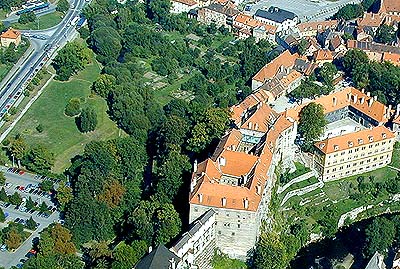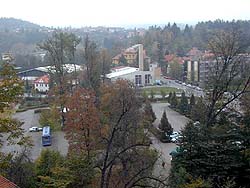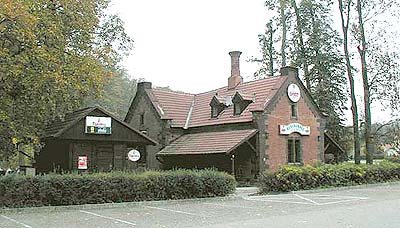The Deer Garden in Český Krumlov
Original name:
In the beginning of the 18th century the location was called "Thier
Garten". The local name Jelení záhrada, meaning Deer Garden, was
documented for first time in the 18th century (Hirschen Garten,
Hirschgraben, Hirschgarten in German) and it illustrates the
original garden function as a game-park.
Description of the garden:
The Deer Garden is located in a broad Polečnice lea strip
(Chvalšinský stream). The area is 7 hectares wide. The area borders
with the castle foothills on the south-east and west with
Chvalšinská road on the north and by street buildings of Latrán
quarter on the east.  The central part of the
garden (with a parking lot and the building of the former seed
separating facility - today's Jelenka restaurant) is located in
the area of the former Renaissance garden which underwent a
complicated development. The green cover consists of plants of
various ages. The youngest are the lime and maple-alleys right in
the area of parking lot. New plantings of bushes and trees cover
the western part of the garden (lea area surrounding Chvalšinský
stream) and sallow, aspen, alder, and sycamore cover both banks
along the stream. Trees grow on the northern slopes between the
castle buildings and Chvalšinský stream lea, and are a mixture of
broad-leaved trees with rich shrubs. The eastern left-bank part of
the garden along Chvalšinská street is a free grass field with
scattered solitary trees and tree groups. A single-row maple alley
lies on the opposite side of Chvalšinská street while alders and
willows run along the stream in front of the right-bank side of the
Deer Garden. The eastern right-bank part of the garden (with its
allotment gardens) has a completely different nature in contrast to
the previous parts of Deer Garden - the wooded areas are mainly
created by fruit trees.
The central part of the
garden (with a parking lot and the building of the former seed
separating facility - today's Jelenka restaurant) is located in
the area of the former Renaissance garden which underwent a
complicated development. The green cover consists of plants of
various ages. The youngest are the lime and maple-alleys right in
the area of parking lot. New plantings of bushes and trees cover
the western part of the garden (lea area surrounding Chvalšinský
stream) and sallow, aspen, alder, and sycamore cover both banks
along the stream. Trees grow on the northern slopes between the
castle buildings and Chvalšinský stream lea, and are a mixture of
broad-leaved trees with rich shrubs. The eastern left-bank part of
the garden along Chvalšinská street is a free grass field with
scattered solitary trees and tree groups. A single-row maple alley
lies on the opposite side of Chvalšinská street while alders and
willows run along the stream in front of the right-bank side of the
Deer Garden. The eastern right-bank part of the garden (with its
allotment gardens) has a completely different nature in contrast to
the previous parts of Deer Garden - the wooded areas are mainly
created by fruit trees.
Significant architectonic
details:
Some of the historical buildings are still preserved in the
territory of the Deer Garden:
- The former seed separating facility (the so-called cone house) now functions as the Jelenka restaurant.
- The wall of the former game-park (the "long wall") is preserved in an uninterrupted length from the crossing with Chvalšinská street to the north end of this street at the homestead of Renaissance house on the 5th castle courtyard. The rubble masonry wall is covered by granite plates and plastered. It was repaired several times in the past and supported by additional posts. The last reparation dates from 1996, after a part of the wall broke as a result of heavy rains and masonry soaking on 20th May 1995.
- The torsos of stone pillars are the remainder of the former footbridge across the Chvalšinský stream. The pillars are made of chiselled stone blocks. The appearance of the old footbridge is documented on old photographs.
- Spring outlet building - the so-called Lvíček (little lion).
- The original ground model of the original Renaissance "island garden" is still visible in the south and east of the parking lot at Jelenka restaurant.
There are also some modern buildings in the garden which went through controversial architectural developments in the last 40 years:
- The building of the gas regulating station in the western part of the garden
- The parking lot with an entrance building and public toilets
- The fences of the allotment gardens and garden houses in the eastern part of the garden
Historical summary of the owners of the Deer Garden area:
- From the 13th century - the Lords of Krumlov
- 1302 - Václav II assigned the Český Krumlov castle to Jindřich (Henry) of Rosenberg.
- 1600 - Petr Vok of Rosenberg sold the Český Krumlov Castle to the emperor Rudolf II and the Deer Garden became the property of the imperial chamber.
- 1622 - December 23rd - the emperor Ferdinand II sold the castle to his chamber counsel and the war council chairman Johann Ulrich of Eggenberg.
- 1719 - Adam Frany of Schwarzenberg took control of the castle after the Eggenbergs died out.
- 1940 - Sequestration was applied to the property of the Hluboká branch of the Schwarzenbergs.
- 1947 - The entire property of Hluboká branch (primogeniture) was expropriated according to the Lex Schwarzenberg
- Act from July 1947 - first it became national property, then after the dissolution of the provincial system in 1949, became state property.
- 1930's - the allotment gardens were doled out to employees of Schwarzenberg forestry.
- 1947 - The property of the Schwarzenberg princes
expropriated.
The role of the Deer Garden in the town planning
structure of Český Krumlov:
The medieval
fortification pond in the north forefield of the castle, and later
game-park together with various kinds of crafts, have taken a very
significant part in forming the urban appearance of Český Krumlov.
Even the town planning concept of this area, which dates back to
the end of the 16th century (the era of Petr Vok) suffered natural
disasters and also damages during the Thirty Years War (especially
the liquidation of the pond!) and until recently it determined the
extent of this location and to a certain extent its function. For
centuries, the historical appearance of the Deer Garden has formed
the base of the monumental silhouette of the castle residence. The
premise pushed the developed suburbian area approximately 150m
towards the north of the castle slope foothills. This historical
area was more or less respected in the past, and buildings were
rather built in the outer parts of the garden. The second half of
this century brought an essential change in the garden's
development. The area of the little park near the seed-unshelling
house (in the place of the original Renaissance garden on the
island) disappeared as a result of its utilization as a bus
station. The parking lot built in the beginning of the nineties
practically destroyed the entire western half of the historic Deer
Garden. Park designing around the blacktop parking spots was
included in the construction plan of the parking lot. Both
Historical Monuments Authorities and non-government initiatives
have forced the designer, investor and supplier to increase the
number of trees in the parking lot area. In spite of this, the
final appearance has already lost (at least at the built-up and
consolidated areas) its garden atmosphere and especially its
character as a historical garden! Although it has ensured the
necessary number of parking spots near the historical centre of
town, the loss of such a large area of the historical garden is
unproportionally high. The current usage of a part of the Deer
Garden as a parking lot should definitely not be final. The
possibility of future rehabilitation of the garden as an integral
architectural complex should remain open.
Conservation of the location:
The part of the Deer Garden south of Chvalšinský stream is located
in the territory of the Český Krumlov, Municipal Historical Reserve
and the garden area north of the stream is located in a preserved
zone of the Český Krumlov Municipal Historical Reserve.
 The present function of
the garden:
The present function of
the garden:
These days the area of the Deer Garden consists of a public
municipal green area, allotment gardens and an extensive parking
lot for passenger cars and coaches. the Restaurant Jelenka and
public conveniences are located in the centre of the garden.
Further information:
Historical
development of garden design in the area of today's Deer
Garden


